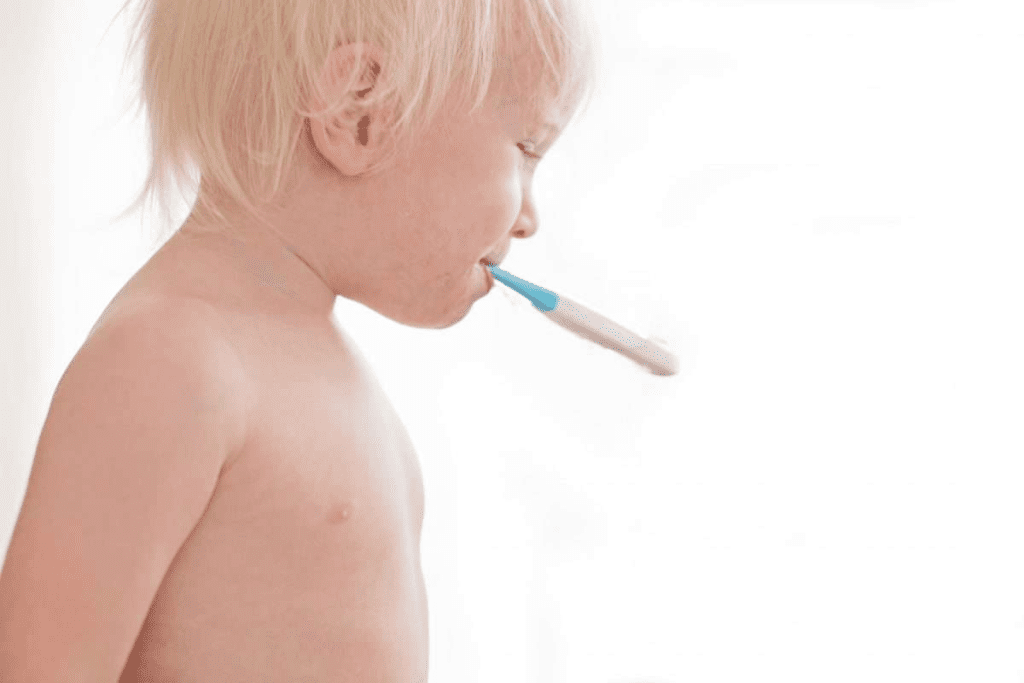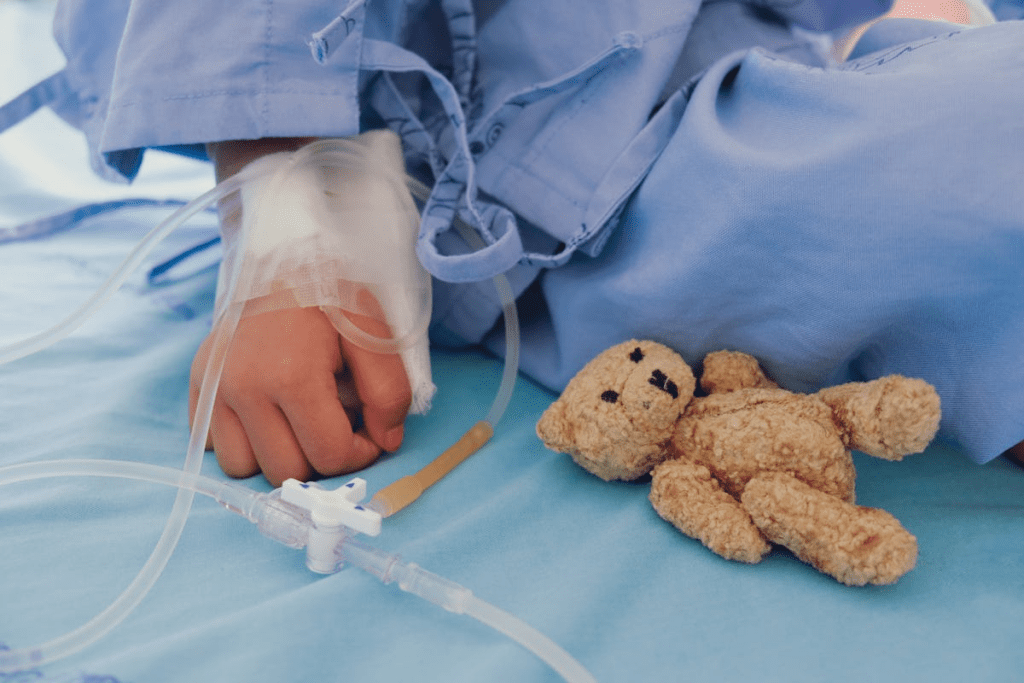Last Updated on November 20, 2025 by Ilayda Cengizhan

A fever in kids is a big worry for parents and doctors. It’s when a child’s fever temperature hits 100.4 °F (38 °C) or more. This happens in kids from birth to age five, checked by a rectal thermometer.
The American Academy of Pediatrics agrees on this number. They say babies 8 to 60 days old with temperatures at or above 100.4 °F need to see a doctor. This is to check for serious infections.
Knowing when a child has a fever is key. It could mean they have an infection. Taking the child’s temperature right is very important. This is true, even more so for newborns, as it might show they need quick help.
Knowing when a child has a fever is key to acting quickly. Fever is common in kids and helps doctors spot serious infections.
A fever in kids is when their body temperature hits 100.4 °F (38 °C) or more. This number is important because it means the child needs to be checked out further.
The 100.4 °F (38 °C) mark is the fever standard for kids, says the American Academy of Pediatrics. It shows the body is fighting off an infection. It’s important for parents to know this number is based on medical advice.
A temperature of 38.5 °C is about 101.3 °F, which is a fever. Knowing how to convert these numbers helps doctors check a child’s health.
The American Academy of Pediatrics (AAP) has rules for dealing with fever in kids. They say babies under 3 months with a fever need to see a doctor right away. This is because they are more likely to have serious infections.
The AAP also looks at how the child feels and acts, not just the temperature. They check for signs like fever symptoms (like being very tired or not wanting to eat).
A temperature of 37.7 °C is about 99.9 °F, which is normal. But if a child has other symptoms, even a slightly high temperature can mean they need to see a doctor.
Fever thresholds change with age in children. It’s key to know these differences. Parents worry about fever in kids, and knowing when it’s serious is important.
Newborns, or neonates, face higher risks due to their young immune systems. A fever in this age is a temperature of 100.4 °F (38 °C) or higher. Fevers in neonates need urgent assessment because they can signal serious infections.
The American Academy of Pediatrics says neonates with fever should be checked quickly. The risk of bacterial infection is high, so caution is advised.
Young infants, from 29 to 60 days old, have a different approach to fever. They are considered high-risk, but management might include clinical evaluation and lab tests to find the fever’s cause.
A temperature of 100.4 °F (38 °C) or more is a fever. Parents should watch closely and seek medical help if their infant seems distressed or the fever doesn’t go away.
Older infants and toddlers have a similar fever definition, with a temperature above 100.4 °F (38 °C) being febrile. But, as they grow, the risk perception and management strategies change.
Parents need to know that fever can mean different things. Watching the child’s overall health and behavior is key. For example, if a child is active and playful without severe distress, it might not be as serious.
Here are some guidelines for fever temperature conversion:
Knowing these conversions helps parents assess their child’s health better. But always talk to a healthcare professional for specific advice.
In conclusion, knowing the fever thresholds for different ages is critical for managing pediatric fevers. By understanding the risks for each age group, parents can make better decisions about when to seek medical help.
It’s very important to measure a child’s fever correctly. This helps figure out if they’re sick and what to do next. The way you measure can really affect how accurate the reading is.
Measuring the temperature in the rectum is the most accurate way, mainly for babies. You need to gently put a thermometer in the rectum. Make sure to use a digital thermometer made for rectal use and follow the instructions. The normal temperature in the rectum is a bit higher than in the mouth, usually around 100.4 °F (38 °C).
To change Celsius to Fahrenheit for rectal temperatures, use this formula: °F = ( °C × 9/5) + 32. For example, 38.3 °C is about 100.9 °F.
For older kids, other ways like oral, axillary (underarm), and temporal artery (forehead) measurements are used. Oral temperature measurement works for kids who can hold the thermometer under their tongue. Axillary measurement is good for young kids or when other methods can’t be used.
Knowing how long a fever lasts is also key. Fever duration can show how serious an infection is. A fever lasting over 72 hours in kids under 2 or more than 5 days in kids over 2 needs a doctor’s visit.

For parents and caregivers, knowing how to measure fever and what it means can help make better health choices for a child.
Knowing the stats on pediatric fevers is key for parents and doctors. It helps them handle fever in kids well. Fevers in kids are common, and knowing the risks helps in giving the right care.
About 14 out of 1,000 healthy full-term babies get a fever in the first two months. This shows why we must watch for fever in this age group closely.
Fever is common in healthy full-term babies. Studies show many of these babies have infections that need doctor visits. For example, over 10% of feverish babies in the first few months have urinary tract infections. This shows why checking for infections is important.
Fever in babies can mean serious infections. About 1 in 100 feverish kids have serious problems. This highlights the need for quick and accurate medical checks.
Some important facts about pediatric fevers are:
For parents and caregivers, knowing these facts helps spot fever risks and get medical help when needed. It’s also important to know how to check fever temperature correctly, as we’ve talked about before.
By understanding fever risks and prevalence, parents and doctors can ensure kids get the right care. This includes knowing serious infection signs and when to see a doctor.
It’s important to know why kids get a fever. Fever is a sign of many infections. Most fevers in kids come from viruses, which often get better by themselves.
Knowing if it’s a virus or bacteria is key. Viral infections are the top cause of fever in kids. They usually get better without needing special treatment.
Viral infections that cause fever in children include:
These viruses spread easily. For example, a fever of 38.5 °C (101.3 °F) might mean your child has the flu.
Bacterial infections can also cause fever and need antibiotics. Examples include:
It’s vital to spot bacterial infections early. This way, we can start treatment fast and avoid serious problems. For instance, a 37.5 °C to Fahrenheit conversion shows a normal body temperature. But, a fever can rise quickly, needing a doctor’s check.
Watching a child with fever is key. If they seem uncomfortable or the fever doesn’t go away, get help. Knowing if it’s a virus or bacteria helps us treat it right.
Pediatric fever can worry parents a lot. It’s important to know when to get medical help. Fevers in newborns need quick attention, and knowing emergency signs is key.
The child’s age affects how serious a fever is. Newborns (0-28 days) should see a doctor for any fever over 100.4 °F (38 °C). Young infants (29-60 days) also need medical check-ups for fevers over 100.4 °F (38 °C).
Key emergency warning signs include:
For older kids and toddlers, these signs also mean it’s time to see a doctor.
How long a fever lasts is also important. For kids under 3 months, a fever over 24 hours is a worry. Kids between 3 months and 3 years should see a doctor if their fever lasts more than 3 days.
According to the Children’s Hospital Los Angeles, watch your child closely. Call a doctor if they seem distressed or have other symptoms with their fever.
It’s always better to err on the side of caution when it comes to your child’s health. If you’re not sure about your child’s fever or if they seem upset, getting medical help is wise. It ensures your child gets the care they need.
Knowing about pediatric fever is key for parents and caregivers. It helps them give the right care and know when to get medical help. A fever is when the body temperature goes over 100.4 °F (38 °C). Temperatures above 103 °F (39.4 °C) need extra attention.
It’s important to measure fever accurately. For babies, using a rectal thermometer is best. Knowing the signs of fever helps decide what to do next. LivHospital shows how to handle fever in kids by focusing on accurate temperature checks and when to see a doctor.
Understanding why fever happens, like from viruses or bacteria, is important. Knowing when to get medical help is also key. For example, a temperature of 101.3 °F (38.5 °C) might not be as serious as one over 103 °F (39.4 °C), which could mean a more serious infection.
A fever is when a child’s body temperature hits 100.4 °F (38 °C) or higher. This is what the American Academy of Pediatrics says.
The best way to check a baby’s temperature is with a rectal thermometer. For older kids, you can use oral, axillary, or temporal artery thermometers.
Babies with fever need quick medical checks. This is because they are at high risk for serious infections.
How long a fever lasts depends on why it’s happening. But most fevers go away in a few days.
Fevers often come from viruses like the flu. Bacterial infections, like ear infections, can also cause them.
Call a doctor if your child has trouble breathing or if the fever doesn’t go away. Follow the guidelines for how long to wait.
Healthy full-term babies often get fevers. Many experience fever in their first few months of life.
First, find out why the fever is happening. Then, help your child feel better. Sometimes, you might need to give medicine to lower the fever.
A fever over 103 °F (39.4 °C) is considered high. It might need more attention and a doctor’s visit.
Yes, the American Academy of Pediatrics has different fever levels for different ages. Babies need extra care because of their risk of infections.
Subscribe to our e-newsletter to stay informed about the latest innovations in the world of health and exclusive offers!